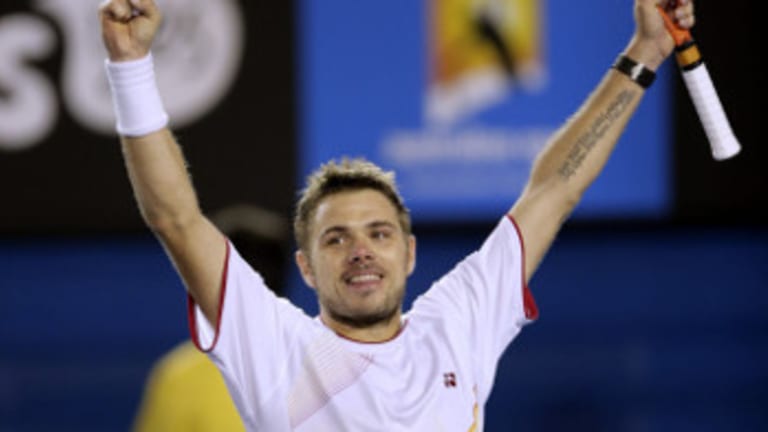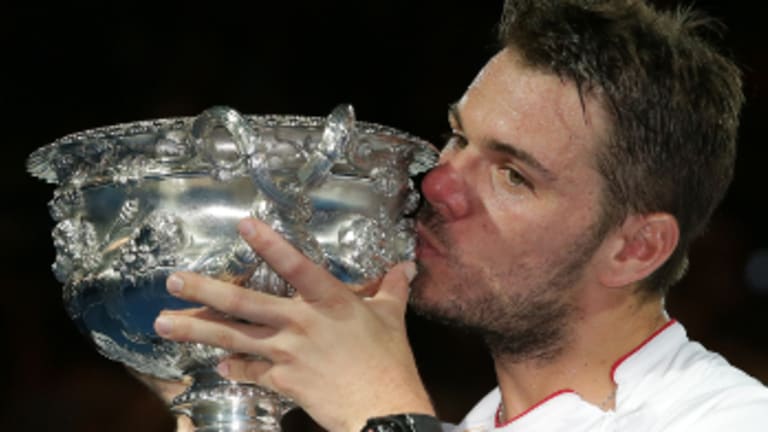Wow-rinka
By Peter Bodo Apr 23, 2014Tsitsipas ends losing streak in ATP 500 finals by beating Auger-Aliassime to win Dubai Championships
By Associated Press Mar 01, 2025Sports on TV for Sunday, March 2
By Associated Press Mar 01, 2025ATP Dubai, UAE
Stefanos Tsitsipas wins Dubai, finally capturing first ATP 500 title of career
By John Berkok Mar 01, 2025Sunshine Symposium: 2025 IW & Miami
Will a 2025 Indian Wells-Miami double happen on the ATP or WTA tour?
By TENNIS.com Mar 01, 2025ATX Open
Jessica Pegula, Emma Navarro march toward weekend hardware in Austin and Merida
By TENNIS.com Mar 01, 2025The Business of Tennis
WTA makes call to 'rally the world' with 2025 rebrand
By Baseline Staff Feb 28, 2025ATP Dubai, UAE
Felix Auger-Aliassime and Stefanos Tsitsipas to play in Dubai final
By Associated Press Feb 28, 2025Month In Review
Which February development on the WTA and ATP Tours was the most significant?
By Steve Tignor Feb 28, 2025Indian Wells, USA
Can Madison Keys win Indian Wells? "It’s never been her favorite surface," says former coach Lindsay Davenport
By Liya Davidov Feb 28, 2025Wow-rinka
Stan's win in Melbourne was gigantic, and so was his title run in
Published Apr 23, 2014
Advertising
One of the least remarked upon features of Stanislas Wawrinka’s victory at the Australian Open is that he was 28 years and 304 days old when he accomplished that feat. That makes him the third-oldest first-time Grand Slam champion among Open era players, if you exclude Petr Korda, who won the 1998 Australian Open at 30 but was later busted as a doper.
Only Goran Ivanisevic—who won Wimbledon in 2001 at 29—and the granddaddy of them all, Andres Gomez, “lead” Wawrinka on the list. The Ecuadorian with the atomic left-handed forehand won the 1990 French Open when he was three months past 30.
It’s surprising that more wasn’t made of the age issue when Wawrinka won in Melbourne, although I suppose the fixation by the world’s medical experts—meaning, you—on the role Rafael Nadal’s sore back played in the proceedings was partly responsible for that. But it wasn’t as if the theme of age has been terra incognita in recent times.
Tommy Haas, momentarily sidetracked by yet another injury, is 36 and still ranked No. 18. David Ferrer, who beat Nadal into the dusty red clay of Monte Carlo just days ago, is No. 5 at 32 years of age. Then we have 31-year-olds Tommy Robredo and Mikhail Youzhny, both still residing in the Top 20. Roger Federer is 32, and he’s probably already getting those offers of a free shoulder bag if he joins the AARP.
The Mighty Fed does travel a lot, and who can’t use an extra bag?

Wow-rinka
Advertising
While Federer has so many Grand Slam titles that he could afford to give a couple away to the Ferrers of this world, Wawrinka doesn’t need to ask his Davis Cup teammate for one. He’s now got his, beating overwhelming odds faced by anyone hoping to win his first major after age 25. Even late-bloomer Ivan Lendl got the job done before he turned a quarter-century, although his protege, Andy Murray, was one of the few who did not—but still came through in the end.
But not much was said about Stan’s advanced age, and for a while there it looked as if it didn’t much matter. Upon his return from the antipodes, he was upset in the fourth round in Indian Wells and Miami (he had byes, too), on surfaces similar to the one on which he’d engraved his greatest triumph. Perhaps that win in Melbourne wasn’t quite as resonant—or indicative of the future—as it appeared to some. Maybe it was more about Rafa’s back than Stan’s grit.
“I only played two tournaments, so it's a bit difficult to say if my results are up and down, and if (that) it's because of emotions,” Wawrinka said early last week in Monte Carlo, referring to a revival of those accusations that he’s always had a champion’s game, but never a champion’s will, or mind.
But Wawrinka calmly insisted that he is indeed a different man, adding: “Many things did change in my career (chief among them, taking on Magnus Norman as his coach). But losing to Dolgopolov (Alexander, who beat Wawrinka in Miami), for example, is not anything to be ashamed of.”
True enough, but in this What have you done for me lately? sport, narratives like the one that defined Wawrinka for so many years can not only stick, they can seep into the consciousness of the subject. A leopard doesn’t change its spots. Inner transfiguration almost three decades in is the stuff of Hollywood, not the pro tour.
The battle to remain positive is the greatest one, by far, in the game.
And that’s exactly why this win last Sunday in Monte Carlo seems so important for Wawrinka. It reinforces the idea that transformational change is possible, that he’s among the elite to stay, even if it may only be for two or three years. Still, that’s no small thing for a player who’s now 29.
Claiming a coveted Masters title that for years now seemed to be reserved almost exclusively for one or another of tennis’ Big Four suggests that Wawrinka really is of champion stock. It diminishes any nagging feeling that he just got lucky that Nadal was not. The victory in Monte Carlo gave Wawrinka’s win in Melbourne a stamp of approval.
It’s interesting to compare his experience with the other two “old” first-time winners.
Gomez’s best result after he won the French Open in 1990 was a semifinal loss to Stefan Edberg in Cincinnati. Otherwise, he didn’t get within sniffing distance of a final weekend anywhere else that year, and he lost first-round matches at Wimbledon and the U.S. Open.
Gomez played just one more singles final in his career, a minor tournament in Brazil. Of course, he was a lot older than Wawrinka when he hit his peak, but the stats are still significant. It isn’t as if Gomez got fitted for dentures the day after he won Roland Garros. The adrenalin rush of winning a major ought to be good for something, even for a senior citizen.
Ivanisevic was much closer in age to Wawrinka when he made a comparable achievement. Yet just like Gomez, the best he could do after winning his maiden Slam was make a semifinal (Indianapolis). And while it’s true that when he won Wimbledon as a wild card, Ivanisevic was banged up and already living, or at least playing, on borrowed time. He never did play another final of any kind after that magical moment. That, too, makes Wawrinka’s win in Monte Carlo shine with greater luster.
It’s ironic that the way Wawrinka repudiated his long-time reputation was by calling upon and harnessing exactly the traits which for so long he was said to lack: Confidence, determination, heart.

Wow-rinka
© AP
Advertising
Going on the evidence of 2014 results, the Big Four now consists of Nadal, Novak Djokovic, Federer and Wawrinka. Perhaps it would be more fitting to expand the group to a Big Five, given that it’s uncharitable to write Murray out of the fraternity despite his slow return from last fall’s back surgery. After all, he’s still got one more major than Wawrinka, a pile more final-round appearances—and a whopping eight more Masters shields.
Wawrinka is fine with that. When a reporter in Monte Carlo tried to wedge him into that elite group, he demurred: “I just think the Big Four will always be the Big Four: Rafa, Novak, Roger, and Murray. They won all the tournaments since many years, and you cannot change that.”
Really, it’s less like Wawrinka has joined the Big Four than that the august quartet may be in the process of dissolution. How odd all this must seem to those who remember the days when Wawrinka acted more like Federer’s butler than his rival when they stepped out on the court to face off. Just read how Wawrinka described their final-round meeting:
“The beginning of the match was a bit tough. But it was for both of us. I saw he was tense, too. We were looking at each other. But. . . before the match we had lunch together. After the match we were laughing together in the locker rooms. That's why also we did well in the Olympics because we did that together.”
As for the idea that Wawrinka somehow has pulled off some drastic change of playing personality, he sees his current success more like the the end result of a process rather than a new beginning.
“It's the same thing I'm doing since many years,” he said. “Maybe that's why I'm so good now. During the last four, five years I didn't change. Like when things went wrong, I focus on what I want to improve.”
Wawrinka’s transformation may beg for more labyrinthian analysis, but as any older person can tell you, sometimes things aren’t nearly as complicated as they appear—or we try to make them.